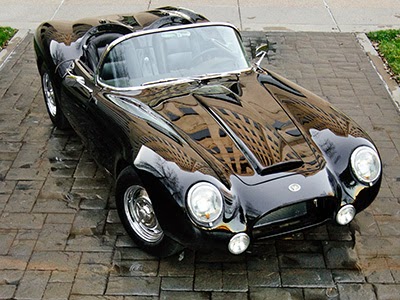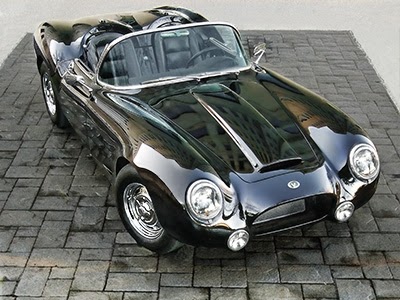Trick Number One: Bracketing
Fair warning: If you've never bracketed before, this post won’t give you a detailed step-by-step. I’m assuming you've done it at least once already.
My favorite way to shoot cars is in direct sunlight. That’s the exact opposite of what everyone
will tell you in photo class. They’ll
say that an overcast day is best, to remove harsh shadows. Well, that’s great for graduation pictures,
but so many car finishes require a strong light to reflect properly that I’ll
actually cancel on overcast days. Most
modern finishes have some degree of metallic or pearl additives, or candy
undercoating. The wonderful effects of
those finishes are completely removed on overcast days.
But a gloss black car doesn't have any of those additives,
so who cares? Well, remember from the
post How to Shoot Black Cars – The Basics that a black car is defined by
its reflections. Shoot on a cloudy day
and your beautiful black coupe will look grey.
Yes, there will be harsh shadows in the sun. So what?
We can fix that, and the result gives us the best of both worlds. The technique is also useful in shows, where
there is extremely high dynamic range present, because of shadows and light
sources both existing in the same shot.
It’s easy to tell whether you need to bracket. Take a properly exposed shot of the car, and
look at the histogram. If it hits both
the right and the left sides, you’re losing information, and you need to
bracket. Leave your camera on the
tripod, and take a minimum of four more shots – one minus half a step, one
minus a full step, and +1/2 and +1 on the positive side also. Now you have five shots, and most people
would combine them in Photomatix (or a similar program) and be done with
it. But you can get a much better
result by combining them with the gentlest settings in Photomatix, then
bringing the result, and all the original shots, into a stack in
Photoshop. Start with the Photomatix
result on top, and using a mask, paint away the portions that don’t look
natural. You’ll need to coordinate this
removal with the appropriate shot beneath, masking off parts of that layer also
to reveal different shots in different places.
This takes a lot of manual work, but the result is far superior to
letting the computer do the work.
You’re trying to make the final shot look the same way your brain saw
the car on location, which the computer is simply not capable of doing. You’d be amazed at how much work your brain
does when your eyes are open. You can
clearly see into the harsh shadows, and all the detail within. No camera can yet do that, because your
brain is doing tremendous amounts of post-processing work in real-time, often
based on what you’re trying to concentrate on at any given moment. Using this manual technique gives you an appreciation
for all that power in your head.
Trick Number Two: Combining for Controlled Reflections
In my blog post How to Shoot Black Cars – The Basics,
I told you to take your polarizer off, to maximize reflections. The next step is to put it back on. But you’re not going to take one shot of the
car, like you would most cars. This
time, you’ll take multiple shots of the car with the polarizer in different
positions. A tripod is critical for
this step, and it should be obvious that you would be using one all the
time. Take around five to eight shots,
but no matter how many you take, make sure you get the entire range of
cancellation from the polarizer.
Combine the shots later in Photoshop, using Lighten to stack each of the
layers on top of each other. Flatten
that stack into a single layer. Now,
layer all the same shots together again, but this time use Darken as your layer
command, and convert that stack into a second flattened layer. Now you have one layer with all the
reflections, and another layer with no reflections. You might want to name them to keep them straight. I usually just name them Light and
Dark.
Place the Light layer with all reflections above the
Dark layer. All you’ll see is the
lighter layer. Add a layer mask to the
Light layer, and paint black on the mask over the places you want to lose the
reflections. Try the windshield, for
example. Other areas you might want to
play with include tires, shiny floors and any interior cloth or leather that
shows. If the resulting effect is too
dramatic, use grey to paint, instead of black.
That will leave 50% of the reflections.
You can also reduce the Opacity of the upper (light) layer, which will
reduce the overall reflectivity of the car.
But be careful with this, as it’s easy to make the car look dull or
dirty. (You can also reverse the
technique, putting the Dark layer on top, filling the layer with black, and
then painting white over the portions you want to bring back. If you’re familiar with layers, then you
probably already thought of that. Use
whichever method feels best for you.)
So why go to all that trouble, you ask? Why not just darken the parts I want to see
darker? Because the polarizer
doesn't darken, it gets rid of reflections.
When you remove the reflective layer from the windshield, you reveal the
interior of the car, not a dark windshield.
This combined shot would not be possible without the described
technique. You’ll also notice that not
all reflections can be removed with a polarizer. Direct lighting (reflections of light bulbs), and any reflection
on chrome, will stay. Getting rid of
those will be a subject for another day.
You may be wondering how to get around having to do all
that. The answer is to control your
environment, which is impossible at a car show, moderately possible on location,
and required in a studio.
The one thing you can control is your shot, which will give
you more creativity. If the car is on
grass, maybe you want to see the grass in the reflection. If the car’s on concrete, maybe you want to
get really low so you don’t reflect the ugly floor. Shoot around those two guys who won’t stop chatting by the
fender, instead of waiting for them to leave.
Shoot from the windshield to the rear to avoid having to show the open
hood. Use a reflection of a person
looking at the car, giving the shot an emotional touch. Shoot from the front to keep away
reflections of other cars. Show the
blue sky, to give the eye an opportunity to see why the top of a black car
looks blue. Find the angle that shows
the most ceiling lights in the car.
Force yourself to FIND the good shots within the environment that’s
presented to you!
Here's the first stack, containing all the shots that have full reflections. This has had a light touch with Photomatix, but most of the effect you see is a result of leaving all the reflections in.




No comments:
Post a Comment